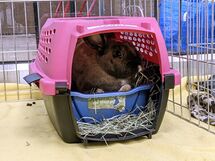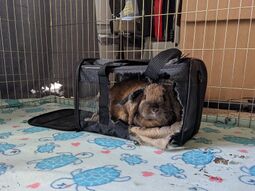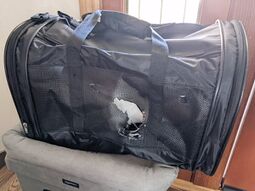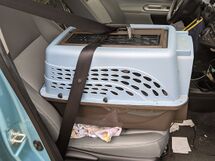Traveling with a rabbit
Traveling with a rabbit is definitely no small task. Quite a bit of preparation and consideration is needed, especially if you do not have rabbit supplies at the destination.
Choosing a carrier
By far the easiest and safest way to travel with your rabbit in most situations is with an animal carrier. An animal carrier sized for multiple cats or a small dog will work best, although extremely large and small rabbits will require different sizes.

A 19" carrier is appropriate for smaller (2-3 lb) pairs and trios or medium-sized rabbit pairs.


A 24" carrier is a comfortable ride for medium-sized (~5 lb) pairs and trios, a larger (7+ lb) rabbit pair, or a single giant (10+ lb) rabbit.
Some examples of great two-door carriers:
- 19" AmazonBasics Two-Door Top-Load Pet Kennel
- 19" Petmate Two Door Top Load Pet Kennel
- 19" IRIS USA Easy Access Pet Travel Carrier with Two Access Doors
- 19" Ferplast Atlas 10 Top Opening Cat and Dog Carrier
- 19" Richell Double Door Pet Carrier
- 19" Frisco Two Door Top Load Plastic Dog & Cat Kennel
- 20" Catit Cabrio Cat Carrier
- 23" AmazonBasics Two-Door Top-Load Pet Kennel
- 23" IRIS USA Easy Access Pet Travel Carrier with Two Access Doors
- 23" Favorite Top Load Pet Carrier
- 23" Ferplast Atlas 20 Top Opening Cat and Dog Carrier
- 23" Marchioro Clipper Aran 2 Pet Carrier
- 23" Petmate Two Door Deluxe
- 24" Petmate Two Door Top Load Pet Kennel
- 24" Frisco Two Door Top Load Plastic Dog & Cat Kennel
Some good top-opening carriers:
- 16" Richell Faux Wicker Pet Carrier
- 16" Top Load Carrier
- 16" IRIS Small Animal Carrier
- 18" Frisco Top Loading Cat Kennel
- 18" IRIS Ohyama Pet Carrier
- 19" Petmate Top Load Cat Kennel
- 19" Petmate Get-A-Round Kennel
Other collapsible and more uniquely-shaped carriers:
Most carriers have a metal grate style door which is simple to hang a water bottle on. We recommend avoiding carriers with a plastic door, as most rabbits will be able to chew out given enough time.
One of the nice features about a carrier is that it is dark and cave-like (for a bunny sense of security) and usually has adequate holes in the side for airflow. You can choose to fit a small litter box inside and either secure a bottle or water crock to the door.
If a litter box will not fit, you may instead cover the entire bottom with litter, a towel, pee pad, or other material to use as padding and soak up urine. Please make sure that the rabbit will not chew and eat the material when unsupervised. You can change the towel during travel breaks if the rabbit soils it.

Some considerations in choosing a proper carrier include the following:[1]
- Ventilation: It is important to have adequate ventilation in the carrier because rabbits can easily overheat in a warm environment.
- Ease to clean: Your rabbit will most likely potty in the carrier, so you will want a carrier than can easily be taken apart and wiped down. Plastic carriers are much easier to clean than soft fabric ones.
- Ease of access: You will need to be able to easily get the rabbit in and out of the carrier. As a result, you may wish to invest in a carrier that you can take the top off and lift them out through. A side door is useful to get the rabbit to hop in on their own.
- Sturdiness: Carriers need to be made of a material that is chew-proof such as wire and hard plastic. You do not want your rabbit to escape while you are driving or waiting for an appointment. Carriers should also be sturdy and securely latched to not fall apart in the midst of transporting.
- Carrying handle/strap: The handle should be securely attached and able to handle your rabbit's weight. Check to see that all hinges are robust. You may wish to invest in a carrier with a strap to help with extra weight if you have multiple rabbits or a large rabbit.
- Size: Choose a carrier so that your rabbits have enough room to stretch out and sit upright comfortably but not enough room to slide around in the case you brake suddenly. You can fit more than one rabbit in a carrier but make sure that it is comfortably sized for both of them.
Some carrier types we do not generally recommend for one reason or the other are the following:
- Wire pet carrier: While these carriers are chew-proof, rabbits may get their legs stuck in the holes, and the open sides may make them feel unsecure. If you use one of these, cover the bottom with a solid surface like a plastic sheet or a towel, and lightly cover the carrier with a bed sheet while continuing to give sufficient ventilation.
- Soft fabric carrier: These carriers are easy to store because they fold but are only suitable for extremely short trips. Rabbits can easily chew through the material and escape if they set their mind to it. However, these can be used if you don't want to advertise the fact that you have a pet and hidden as a gym bag. Throw a towel over it, and no one will know what is underneath.
- Bubble carrier backpacks: These generally have soft sides that rabbits can easily chew through in minutes. The cheaper versions have very poor ventilation with non-breathable fabric - they can easily cause a greenhouse effect and heatstroke in your rabbit in less than 30 minutes.
- Wicker pet basket: Similar to the soft fabric carrier, rabbits can easily chew through the side in minutes.
- Cardboard carrier: Like the most of other unsuitable materials, these can be easily chewed through in minutes. Additionally, you will need to make sure they get adequate ventilation through holes punched in the side. These are also not easy to clean if the rabbit soils the bottom.
Some completely unacceptable ways to travel with your bunny are free-roaming or on a halter and leash. It is important to secure your rabbit in the case of sudden starts and stops. A halter and leash do not provide enough security in the case of an accident.
The following are a few more resources about choosing a carrier for your rabbits:
- MediRabbit. Best type of carrier for rabbit transport
- Suzanne Trayhan. (2009). Choosing a Carrier for Transport
Travel by car
A rabbit can travel quite comfortably in a car, but you will need to work a little bit to keep them happy and cool.
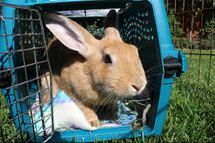
There are two things that are good to keep in mind when traveling with your rabbit in the car. One is the rabbit's stress level, and the other is the temperature inside the car.
The car is an unfamiliar environment for a bunny and is filled with strange noises and weird smells. The rabbit has no idea why all of a sudden they have been taken out of their normal environment and subjected to a moving vehicle.
Give your rabbit a cave- and den-like setting if possible. Generally pairs of rabbits do very well in the car because they have another bunny to cuddle with and take comfort in. If you have a single rabbit, a familiar stuffed animal may make a good companion during the car ride. Please make sure the rabbit does not try to chew and eat the stuffed animal. Try to drive such that you minimize the jostling of the bunny if you can - no sudden stops, jerky acceleration, or sudden lane changes. Keep the volume on the radio moderate, and the windows mostly closed.
When placing the bunny carrier in the car, make sure that it is secure and as level as possible. The floor behind the passenger seat is the best location and also prevents the entire carrier from sliding. If you place the rabbit on the seat, you can place the seat belt through the handle to secure it in place. Pull the seat belt to the end to lock the seat belt length. Most seats are sloped downwards - you may need to put a towel or blanket on the seat to make it level for a carrier.
Be conscious of the temperature in the car. Rabbits can be sensitive to temperature, so if you are traveling in the summer, keep that A/C on, and in the winter, keep the heat running. It may be a good idea to turn the car on 15 minutes before you head out so it can either heat up or cool down before you bring the rabbits on board if the current temperatures are extreme.
For carriers with a slippery plastic bottom, place a small rubber mat for grip and overlay with pee pads, towels, shirts, or bedding to soak up any urine during the trip. You can also fill the entire floor with a layer of hay.
Make sure that your rabbit has access to food and water for the duration of the car ride if the trip is over a couple of hours. Cold wet vegetables in the carrier would fulfill this requirement if a bowl will be too messy and your rabbit does not know how to drink from a water bottle. Some owners fit entire litter boxes with hay inside the carrier for convenience. Any bowls or food and water containers should be secured to the sides of the carrier to prevent movement. Check up on your rabbits every time you pull over to make sure they are not overheating and to swap out any towels or pee pads if they have been overly soiled.
If your trip is under 8 hours, we would suggest just driving through without any stops unless you plan on taking a break for over an hour in the middle of the trip. Rabbits will often be under too much stress to try to eat during short 30-minute stops. If your rabbit has not eaten at a stop break for over 8 hours, it is a good idea to assist feed some food after checking they are not bloated to make sure they have something in their stomach until you stop overnight. It is also a good idea to have a rabbit-savvy veterinarian or emergency hospital prepared at your final destination in case of full stasis.
See the resources below for more information on car travel with rabbits.
- Esther van Praag, Ph.D. Safe transport by car
- Wendy Lincoln. Traveling with Bunny
- Bunny Approved. (2014). Transporting Rabbits in a Car
Experiences
Below are links to anecdotes of people who have traveled with rabbits by car.
- Shannon Twohig. (2025). Driving with Bunnies by Car from California to Virginia
- u/zLightspeed. (2023). Rabbit was driven 1200km (14 hours) in China without stopping by friends.
- u/Kronh. (2023). Drove from Nashville to Los Angeles, a 30-hour trip, with 3 rabbits
- Roaming with Rabbits
- Elizabeth R. TeSelle. Rabbits on the Road
- Jennifer J. (2016). Notes from a First-Time Bun-Mom: Driving Cross-Country with Rabbits
Travel by airplane
Although a less common method of travel, rabbits can be transported across the country by air. However, many airlines do not allow rabbits to fly in the cabin and classify them as rodents (incorrectly) or livestock.
Airlines that allow rabbits in the cabin
Before booking tickets, make sure to call the airline and ask for current information on traveling with a rabbit.
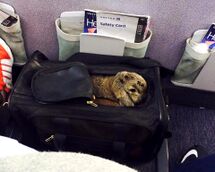
As of June 2025, a few airlines that will allow rabbits in the cabin for domestic US flights are the following:
As of July 2024, the following are a few airlines that may allow rabbits in the cabin on international flights.
- Finnair (only on flights originating in the EU)
- ITA Airways
- La Compagnie (only "dwarf" rabbits)
Many private charters may allow pets in-cabin if money is no issue.
For more airlines and complete details visit the Rabbit-friendly airlines page.
Airlines and emotional support rabbits
Some airlines that normally would not allow a rabbit to travel in the cabin or charge a pet fee may make an allowance if the rabbit has documentation as an emotional support animal (ESA) and is needed by the passenger. Check directly with the airline for their complete rules before booking tickets.
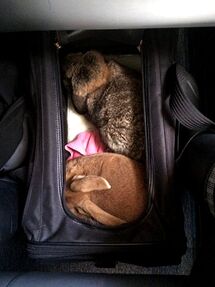
Please note that airlines are never required to accept rabbits on their flights, even if the rabbit is documented as an ESA and the airline allows other types of ESA animals such as dogs and cats.[2] Additionally, emotional support animals are an US-centric concept. Flights to and from other countries are not subject to ESA rules that may apply to the airline domestically.
General tips
It is not recommended to fly a rabbit in the cargo hold if alternatives are available because it is far safer for you to be able to keep an eye on your rabbit than unattended in another part of the plane. However, many rabbits have traveled safely in live cargo, as it is often temperature and pressure-controlled like the cabin. Going through a professional animal transportation agency will also help insure a quality of care as they will have agents to oversee every part of the process. When choosing an airline to use for cargo transport, check their statistics with animal shipping (especially with exotics and zoo animals) and mortality rates - most airlines should have this published.
If you must fly your rabbits as checked baggage during hot weather, arrange the flight so that they will be loaded during the coolest part of the day. Rabbits can easily overheat and suffer from heat-stroke if left on the tarmac.
Check out Rabbit-friendly airlines for more information about pet-friendly airlines. See Rabbit-Friendly Transportation Agencies if you are unable to find an airline that will allow you to transport your rabbit with you.
Traveling by air is stressful for rabbits, and care should be taken to reduce risks. When possible, choose a direct flight which will not only reduce overall travel time but will also reduce pressure changes with layovers. Consider assist feeding some Critical Care and a full meal before the rabbits leave to make sure they are hydrated and have food in the stomach if they end up not eating at all during travel. Do some research about local rabbit-experienced veterinarians at your destination in case of health complications.
Fly with your pet is a Facebook group that advocates for rabbits to be allowed in the cabin when flying.
The following are some useful general links with more information about air travel.
- Beth Woolbright. (1993). To Fly Or Not to Fly
- US Department of Transportation, Aviation Consumer Protection and Enforcement, Air Travel Consumer Report (look through reports for Incidents Involving the Loss, Injury or Death of Animals)
Appropriate airline travel carriers
Be sure to check with the airline when booking your flight with your rabbit(s) to figure out what the maximum carrier size is and whether or not you can put multiple rabbits in the same carrier.
In the cabin
Hard carriers that fit within airline guidelines can be extremely difficult to find these days. If you must use a soft carrier, try to find ones that are more sturdy and made with thicker materials to discourage quick escape. When you travel, bring extra chewing toys, towels, and cardboard sheets to use to block and distract your rabbit if they are set on chewing and digging at their carrier.
The following are a few carriers that can be appropriate for cabin travel and placed underneath the seat:
- Petmate Traveler Underseat Carrier: hard, 17" X 11.75" X 8"[3]
- Petmate Cabin Kennel Solid Top: hard, 17" X 12" X 8"[4]
- Away Travel The Pet Carrier: soft, 18.7" x 10.8" x 10.75"[5]
- Diggs Passenger Travel Carrier: soft, 20" x 10.8" x 11.5"[6]
Packing for airplane travel
Traveling with a rabbit by air takes some more planning than an ordinary flight. An airline approved carrier should contain the following:
- Towels or puppy pee pads for accidents if the bottom isn't a full litter box setup
- Hay, pellets, and vegetables - Note: Hay and fresh greens may be prohibited if traveling internationally or to agriculture protected areas such as Hawaiʻi
The following should be packed in either the side pocket of the carrier if it has one or in another carry-on bag:
- Additional food
- Critical care package and feeding syringe
- Extra towels or puppy pee pads
It is also wise to check a bag with additional supplies for when you land. This bag should contain the following:
- Hay, pellets, and other non-perishable food items - Note: If you travel internationally, hay may be prohibited.
- Water bottle or bowl
- Food bowl
- Litter box and substrates
Flying internationally
Flying internationally across countries will need a different approach than a flying domestically in a country. You will need to do research for your destination country to see what sort of paperwork, quarantine, and other import regulations you need to follow to have your rabbit safe with you. Additionally, customs will often not allow you to bring hay and fresh greens on the flight for your rabbit. See the main International Import Regulations for Pet Rabbits for some detailed country-specific information.
The following are a few airlines that may allow rabbits in the cabin on international flights.
- Finnair (only on flights originating in the EU)
- ITA Airways
- La Compagnie (only "dwarf" rabbits)
If you must fly or ship your rabbit through cargo, try to use an airline or transportation agency experienced with exotic or zoo animal shipping. The following are a few recommendations:
Experiences
Some experiences of fellow rabbit owners who have transported their pets by air are listed below. See International Import Regulations for Pet Rabbits for more anecdotes.
- u/Pipiru. (2025). International travel from San Francisco to Amsterdam with ITA Airways in cabin
- u/liyalilia. (2025). International move from Saudi Arabia to Qatar (2 hours) to US (16 hours) with Qatar Airways in cargo
- u/ffrothicoffi. (2025). International move with 5-year-old rabbit from Southeast Asia to Scandinavia with Malaysia Airlines/Qatar Airways in cargo
- Angela Chou. (2024). International travel from London to Philadelphia with La Compagnie in cabin
- Spunkie The Bun. (2023). International flight from US to Vietnam with Finnair in cabin and driving in Asia
- u/flamand_quebec13. (2022). International flight from Halifax to France with Westjet in cabin
- Lexi Kilmartin. (2022). International move from Ireland to Canada with Air Canada in cargo
- Aylín Leiva. (2022). International flight from Taiwan to Hungary with JAL in cargo from Taiwan to Helsinki and Finnair in cabin from Helsinki to Hungary
- Stolen Our Hearts. (2022). Flying to Hawaii With Two Bunnies
- u/BaldwinSmithie. (2021). Domestic flights with Frontier
- Monica Djatmiko. (2021). International move from Belgium to Indonesia with KLM in cargo
- Kim Berly. (2021). International move from US to Germany with Lufthansa in cargo
- unknown. (2020). International flight from US to Germany for a Flemish Giant in cargo with Lufthansa
- u/rainyraine. (2019). Domestic flights between New Brunswick and Toronto for a pair of bonded rabbits in cargo with Westjet
- Maerwen. (2019). Domestic flight from Los Angeles to Seattle with Alaska
- (2019). International flights between US and France with United in cabin with a pilot exception
- u/undercoverraptor389. (2018). Domestic flight from East Coast to Los Angeles with Frontier
- u/jjjjjrrrrr. (2018). Domestic flight with two bonded rabbits with United
- Heylee Heylee. (2018). Domestic move with 14-hour flight from East Coast to Hawaii in cargo
- u/owlpee. (2017). Domestic flight for two rabbits with Spirit
- u/trulooloo. (2016). Domestic cross-country flight
- u/decptacon3. (2016). Domestic flight with rabbit as an ESA
- u/Distortionizm. (2013). Domestic cross-country flight with United
- u/orchardraider. (2012). International move from UK to US using IATA transportation agency with rabbits in cargo
- Bunspace. (2010). Experiences flying in cargo hold
- Jennie Langdon. (2003). International moves from US to Austria and back again with rabbits in the cabin
- Blanche Bounds. (2002). The Flying Rabbits: Air Cargo Class from Saudi Arabia to Texas
Here are some vlogs and videos about flying experiences:
- Youtube, jessicayschu
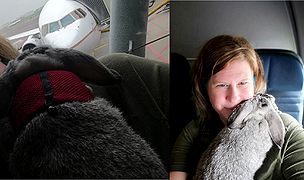
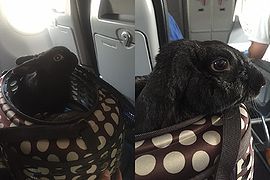
Travel by train
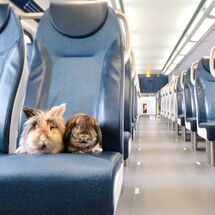
Amtrak in the United States only allows cats and small dogs under their current pet policy on trips less than 7 hours.[7]
To petition Amtrak to allow rabbits in the United States and Canada, please send the suggestion to their support email.
Finding a rabbit-friendly hotel
In the US, the following hotel chains allow rabbits:
- Red Roof
- Motel 6
- Select IHG Hotels (Holiday Inn, Kimpton, etc.)
De-stressing & calming products
New research has shown that gabapentin can help with stress relief if given 2 hours beforehand.
- Jessica Cox. (2022). For rabbits that won’t relax at the vet, meds may provide stress relief
- Rachel E. Conway et al. (2023). Behavioral and Physiologic Effects of a Single Dose of Oral Gabapentin in Rabbits (Oryctolagus cuniculus)
The following over-the-counter rabbit-safe herbal products may assist in reducing anxiety in your rabbit for travel if fed beforehand:
- Small Pet Select, Zen Tranquility Herbal Blend
- The Well Kept Rabbit, Nervous System Support
Further reading
- Bunny Boy Denali. (2021). Travelling with a bunny
- Rabbit Rescue Inc. Travelling
- Ontario Rabbit Education Organization. Travelling
- House Rabbit Society. (2011). FAQ: Vacations and Travel
See also
References
- ↑ The Rabbit House, Rabbit Carriers
- ↑ U.S. Department of Transportation. (2020). Service Animals (Including Emotional Support Animals). Retrieved 10 Sep 2020 from https://www.transportation.gov/individuals/aviation-consumer-protection/service-animals-including-emotional-support-animals
- ↑ Petmate. (n.d.). Petmate Traveler Underseat Carrier. Retrieved 23 Nov 2016 from http://www.petmate.com/product/Petmate-Traveler-Underseat-Carrier/21514
- ↑ Petmate. (n.d.). Petmate Cabin Kennel Solid Top. Retrieved 23 Nov 2016 from http://www.petmate.com/product/Petmate-Cabin-Kennel-Solid-Top/21050
- ↑ Away Travel. (n.d.). Away Travel The Pet Carrier. Retrieved 13 Feb 2022 from https://www.awaytravel.com/travel-bags/pet-carrier?color=coast_nylon
- ↑ Diggs. (n.d.). Diggs Passenger Travel Carrier. Retrieved 13 Feb 2022 from https://www.diggs.pet/products/passenger-travel-carrier/?variantId=40754762252474
- ↑ Amtrak. (n.d). Pets on Amtrak. Retrieved 24 Oct 2021 from https://www.amtrak.com/pets



